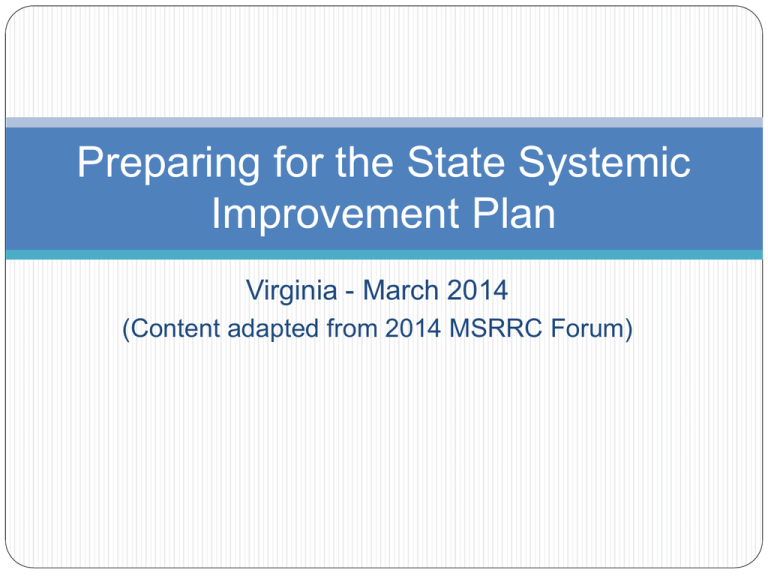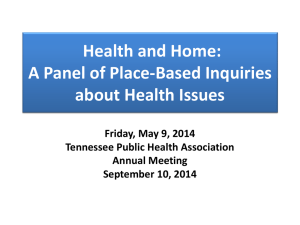Preparing for SSIP – VICC 3-12-2014
advertisement

Preparing for the State Systemic Improvement Plan Virginia - March 2014 (Content adapted from 2014 MSRRC Forum) First thoughts … Overview Part of the SPP/APR Comprehensive, ambitious yet achievable Plan for improving results for infants and toddlers with disabilities and their families Multi-year plan developed in two phases Must engage stakeholders in the process 4 Phase I Components Theory of Action What will we do about it? Data Analysis Infrastructure Analysis • In-depth Analysis of Quantitative and Qualitative Data Related to Primary Concern Area to Confirm Focus Area for Improvement Why is it happening? • In-depth Analysis of Quantitative and Qualitative Data Related to Primary Concern Area to Confirm Focus Area for Improvement Focus for Improvement Infrastructure Analysis Data Analysis • Broad Analysis of Quantitative and Qualitative Data to Identify Areas of Low and High Performance What is the problem? • Broad Analysis of Quantitative and Qualitative Data to Identify Systemic Issues Impacting Performance Data Analysis Identify and analyze key data to determine areas for improvement Disaggregate data as needed Look at data quality Determine any compliance issues that are barriers Start BROAD Identify areas of high and low performance Identify potential focus area for improvement Variety of Data Sources Quantitative Data SPP/APR data, Section 618 data (child count, etc.) Other data related to infants and toddlers (Health, DOE, Infant Mental Health, etc.) Qualitative Data Feedback from VICC Focus groups Surveys Infrastructure Analysis Analyze capacity of system to support improvement and build capacity in EI programs and providers to implement EBP to improve results for infants, toddlers, families Analyze initiatives in state that can have impact on infants, toddlers, families Describe how decisions are made within state system and representatives that must be involved in planning for systemic improvements Start BROAD – “big picture” view System Components Governance Monitoring and Accountability Fiscal Broad Infrastructure Analysis Technical Assistance Quality Standards Data Professional Development Primary Area of Concern Area(s) in which there is lower performance and, if addressed, could have most impact on outcomes for children and families Factors to consider in prioritizing: Magnitude of concern Equity issue Agency priorities Leveraging of resources Feasibility/doability Becomes the potential focus area of improvement for the SSIP Phase I Components Theory of Action What will we do about it? Data Analysis Infrastructure Analysis • In-depth Analysis of Quantitative and Qualitative Data Related to Primary Concern Area to Confirm Focus Area for Improvement Why is it happening? • In-depth Analysis of Quantitative and Qualitative Data Related to Primary Concern Area to Confirm Focus Area for Improvement Focus for Improvement Infrastructure Analysis Data Analysis • Broad Analysis of Quantitative and Qualitative Data to Identify Areas of Low and High Performance What is the problem? • Broad Analysis of Quantitative and Qualitative Data to Identify Systemic Issues Impacting Performance In-Depth Data and Infrastructure Analysis Focus on the primary area of concern Purpose: Identify focus for improvement and determine the systemic issues that need improvement (contributing factors, root causes) Ask more specific questions based on findings from broad analysis May need to collect more data but don’t overdo it Consider qualitative data Focus for Improvement The area of improvement on which the State will focus, that will lead to a measurable child or family result How addressing this area of focus for improvement will build local systems’ capacity to improve the identified result for children and families “Good” Focus for Improvement • • • • • • • • Is supported by the data Will make a significant impact on results Aligns with current priorities and initiatives Will (has potential to) leverage resources Addresses issues of disparate outcomes Is supported by leadership Has the necessary commitment to change Is feasible/doable (2-4 years) Examples of Focus Area Improving social emotional outcomes for children with autism Improving families’ ability to help their child develop and learn Improving social emotional outcomes for children with disabilities Phase I Components Theory of Action What will we do about it? Data Analysis Infrastructure Analysis • In-depth Analysis of Quantitative and Qualitative Data Related to Primary Concern Area to Confirm Focus Area for Improvement Why is it happening? • In-depth Analysis of Quantitative and Qualitative Data Related to Primary Concern Area to Confirm Focus Area for Improvement Focus for Improvement Infrastructure Analysis Data Analysis • Broad Analysis of Quantitative and Qualitative Data to Identify Areas of Low and High Performance What is the problem? • Broad Analysis of Quantitative and Qualitative Data to Identify Systemic Issues Impacting Performance Theory of Action Describe the general improvement strategies that will need to be carried out and the outcomes that will need to be met A series of if-then statements Make connection between what you are doing (Improvement Strategy) and what you expect to happen (Results) Focus on how and why you will produce the change, using “if-then” statements to generate a logical explanation (Rationale) and reveal strategies and assumptions about how resources and activities are used Example If I eat just before going to the grocery store, then I will be full and not craving a sugary treat while shopping. If I’m full and not craving a sugary treat while shopping, then I’ll be able to resist buying candy at the checkout If I can resist buying candy at the grocery store, then I won’t have candy around the house If I don’t have candy around the house, I will eat less candy What do we know about how practices need to look in order to achieve the outcomes? Governance Quality Standards result Funding/ Finance Implementation of effective practices Personnel/ Workforce (PD&TA) Monitoring and Accountability Data System Improved outcomes for children and families What do we know about how the system needs to look in order to support the practices? Governance Quality Standards result Funding/ Finance Implementation of effective practices Personnel/ Workforce (PD&TA) Monitoring and Accountability Data System Improved outcomes for children and families Relationships between Levels of the System to Achieve Results State System: Implementati on of effective state systems that support effective practices What specific state system supports are needed to encourage/ require practices? Local System: Implementati on of effective local systems that support effective practices What specific local system supports are needed to encourage/ require practices? Direct Support: Implementati on of direct support for effective practices (e.g., training, TA, coaching and other supports) What specific direct support is needed to give practitioners the skills to implement effective practices? Practices: Implementati on of effective practices by teachers and providers What specific practices need to occur to accomplish the specific outcomes? Result: Improved outcomes for children and families What specific outcomes or population is the focus? Phase I: • Initiate data analysis • Identify problem area (Focus for Improvement, e.g. child outcomes for low income children) Phase III: • Evaluate progress annually • Adjust plan as needed What is the problem? SSIP Phase I and II: • Search/evaluate evidencebased solutions (Exploration Phase) • Develop Theory of Action • Develop and implement plan for improvement (Implementation Framework) Phase I: • Conduct infrastructure analysis to identify system strengths and barriers • Conduct root cause analysis to identify contributing factors Source: Western Regional Resource Center. Virginia SSIP Development By 4/30/14 • Project & Communication Plan • Stakeholders By 3/31/14 • Broad data & infrastructure analysis • VICC and LSM Meetings By 6/11/14 • In-depth data & infrastructure analysis • Focus for improvement Virginia SSIP Development By 9/30/14 By 12/10/14 By 2/1/15 • Theory of Action • VICC and LSM Meetings • Draft of complete written document • VICC and other stakeholder final review • Final revisions • Submit to OSEP The C in Part C is for …








